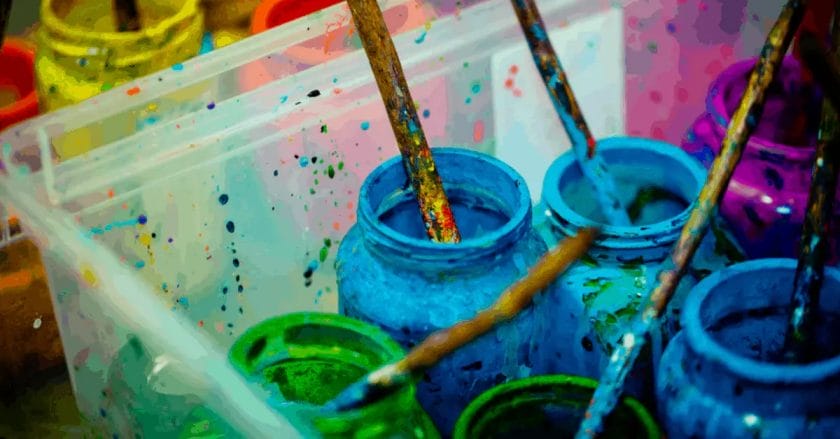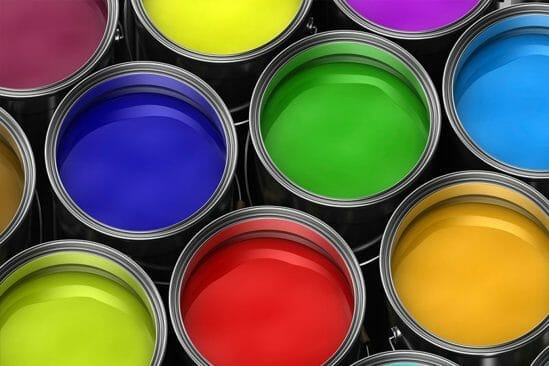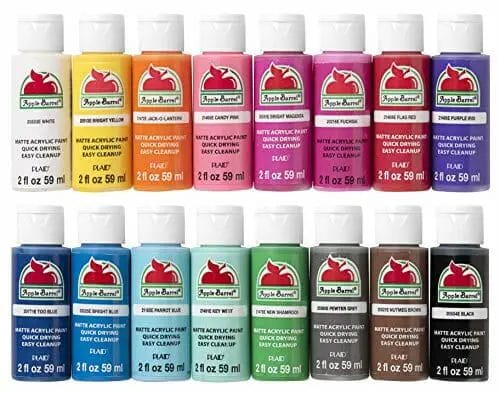Yes, acrylic paint is water-based, which means it is made using water as a solvent instead of traditional oil-based solvents. This makes it easier to clean up with water and allows for quick drying times.
Acrylic paints have gained popularity among artists and hobbyists due to their versatility and ease of use. They can be used on a variety of surfaces, including canvas, paper, wood, and even glass.
With vibrant colors and good color retention, acrylic paints allow artists to create a wide range of effects, from smooth and opaque layers to translucent washes. They also offer the ability to mix colors and create unique shades to suit individual artistic visions.
Furthermore, acrylic paints can be used in different techniques, such as layering, glazing, and impasto, providing artists with endless creative possibilities.
Whether you are a professional artist or a beginner, acrylic paint’s water-based formula makes it a convenient and accessible medium to work with, offering both durability and versatility.

How to clean and work with water-based acrylic paint
Water-based acrylic paint is a versatile and popular choice among artists and crafters. It offers vibrant colors, quick drying time, and easy clean-up. Whether you are a beginner or an experienced painter, knowing how to properly clean and work with water-based acrylic paint is essential for achieving the best results. In this section, we will guide you through the step-by-step process of cleaning your brushes and surfaces, as well as provide tips for working with water-based acrylic paint effectively.
Cleaning your brushes
Properly cleaning your brushes after using water-based acrylic paint is crucial to maintain their longevity and ensure optimal performance. Here’s a simple guide to help you clean your brushes effectively:
- Start by wiping off excess paint from the brush using a clean cloth or paper towel.
- Rinse the brush under warm water to remove any remaining paint.
- Apply a small amount of mild soap or brush cleaner to the bristles.
- Gently massage the bristles with your fingers to work the soap into the brush.
- Rinse the brush thoroughly under running water until the water runs clear.
- Reshape the brush with your fingers and lay it flat to dry or hang it upside down to prevent water from accumulating in the ferrule.
Cleaning your surfaces
Accidental spills or paint smudges on surfaces can happen while working with water-based acrylic paint. To effectively clean these surfaces, follow these steps:
- For non-porous surfaces like glass or plastic, use a damp cloth or sponge to wipe away the paint. You can add a mild soap or household cleaner for stubborn stains.
- For porous surfaces such as fabric or wood, immediate action is important. Blot the excess paint gently with a clean cloth or paper towel without spreading it further. Then, rinse the area with water and use a mild soap or fabric cleaner to remove any remaining paint.
- If the paint has already dried, you can try using a paint remover specifically designed for water-based acrylic paint. Follow the instructions on the product carefully and test it on an inconspicuous area first.
Working with water-based acrylic paint
Now that you know how to clean your brushes and surfaces, let’s explore some tips for working with water-based acrylic paint:
- Start with a clean and well-prepared surface. Remove any dirt, dust, or grease to ensure proper paint adhesion.
- Use a palette or disposable palette paper to mix your colors. This allows you to easily clean up and reduces waste.
- Keep a spray bottle filled with water nearby. Spraying a mist of water on your palette or canvas can help keep the paint moist and workable for a longer period.
- Experiment with different techniques and tools such as brushes, palette knives, or sponges to create texture and effects.
- If you make a mistake, don’t worry! Water-based acrylic paint is forgiving and can be easily corrected. Simply let the paint dry and paint over it.
In summary, cleaning and working with water-based acrylic paint involves proper care for your brushes and surfaces, as well as employing effective techniques. By following these guidelines, you can enjoy the benefits of water-based acrylic paint and create beautiful artworks with ease.

Comparing Water-Based Acrylic Paint with Other Types of Paint
When it comes to choosing the right paint for your next project, there are various options available in the market. Each type of paint has its own unique characteristics and advantages. In this section, we will explore the features and benefits of water-based acrylic paint and compare it with other popular types of paint.
Water-Based Acrylic Paint
Water-based acrylic paint is a versatile and widely used type of paint that is known for its quick drying time and ease of use. It is made from a water-soluble acrylic polymer, which gives it a smooth and creamy consistency. Here are some key advantages of water-based acrylic paint:
- Durability and Longevity: Acrylic paint forms a durable and long-lasting coating on surfaces, making it suitable for both interior and exterior applications. It is resistant to fading, cracking, and peeling, ensuring that your painted surface remains vibrant and intact for years to come.
- Wide Range of Colors: Acrylic paint is available in a wide spectrum of colors, allowing artists and DIY enthusiasts to explore their creativity and achieve the desired look. It can be easily mixed and blended to create custom shades and unique effects.
- Fast Drying Time: One of the major advantages of water-based acrylic paint is its quick drying time. Unlike oil-based paints, acrylic paint dries rapidly, enabling multiple layers to be built up in a shorter span of time. This is particularly beneficial when working on time-sensitive projects.
- Easy Cleanup: Cleaning up after using water-based acrylic paint is a breeze. Since it is water-based, you can simply wash your brushes and palettes with soap and water. This makes it a convenient choice for artists and hobbyists who value easy maintenance.
- Low Odor: Compared to oil-based paints, water-based acrylic paint has a lower odor, making it more pleasant to work with, especially in indoor settings. It is a safer option for individuals with respiratory sensitivities or those who prefer a more eco-friendly approach.
Comparison with Other Types of Paint
Now, let’s compare water-based acrylic paint with other commonly used types of paint:
| Type of Paint | Advantages | Disadvantages |
|---|---|---|
| Oil-Based Paint |
|
|
| Lacquer Paint |
|
|
| Latex Paint |
|
|
In summary, water-based acrylic paint offers a range of benefits that make it a popular choice among artists, DIY enthusiasts, and professionals alike. Its durability, fast drying time, wide color range, and ease of cleanup make it a versatile and convenient option for various projects. While other types of paint

Tips for achieving professional-looking results with water-based acrylic paint
Water-based acrylic paint is a versatile medium that offers a wide range of possibilities for artists. Whether you are a beginner or an experienced painter, here are some useful tips to help you achieve professional-looking results with water-based acrylic paint.
1. Prepare your surface
Before you start painting, it is important to properly prepare your surface. Make sure it is clean, dry, and free from any dust or debris. You can also consider applying a primer to create a smooth and even base for your paint.
2. Use high-quality brushes
The type and quality of brushes you use can greatly affect the outcome of your painting. Invest in a set of good quality brushes that are suitable for acrylic paint. Different brushes have different purposes, such as flat brushes for large areas and detail brushes for intricate work.
3. Thin your paint with water
Water-based acrylic paint can be diluted with water to create different effects. By thinning your paint, you can achieve smoother brushstrokes and create transparent layers. Experiment with different ratios of paint and water to find the desired consistency.
4. Build up layers
One of the advantages of acrylic paint is its fast drying time. Take advantage of this by building up layers of paint. Start with thin washes and gradually add thicker layers to create depth and texture in your artwork.
5. Use a palette knife
A palette knife can be a valuable tool for creating interesting textures and effects in your paintings. You can use it to apply thick layers of paint, scrape off excess paint, or create unique patterns. Experiment with different techniques to add dimension to your artwork.
6. Blend and mix colors
Acrylic paint can be easily mixed and blended together to create a wide range of colors. Take the time to experiment with mixing different hues and shades to achieve the desired color palette for your painting. Use a palette or a mixing tray to keep your colors organized.
7. Work with layers
Acrylic paint dries quickly, allowing you to work in layers. This means you can paint over areas that have already dried without disturbing the underlying layers. This technique is particularly useful for adding details or making corrections to your artwork.
8. Add texture with additives
If you want to add texture to your paintings, consider using additives such as gels or modeling paste. These can be mixed with acrylic paint to create thick and textured effects. Experiment with different additives to achieve the desired surface texture.
9. Protect your artwork
Once your painting is complete, make sure to protect it with a varnish or a clear acrylic medium. This will not only enhance the colors but also protect the surface from dust and fading. Follow the instructions on the product for best results.
10. Practice and experiment
Like any art form, the key to achieving professional-looking results with water-based acrylic paint is practice. Take the time to experiment with different techniques, materials, and styles. Keep exploring and pushing the boundaries of your creativity.
In summary, by properly preparing your surface, using high-quality brushes, thinning your paint with water, building up layers, using a palette knife, blending and mixing colors, working with layers, adding texture with additives, protecting your artwork, and practicing regularly, you can achieve professional-looking results with water-based acrylic paint. Embrace the versatility of this medium and let your creativity soar.
5. Common Misconceptions about Water-Based Acrylic Paint
Water-based acrylic paint is a versatile and popular choice for artists, DIY enthusiasts, and professional painters alike. However, there are some common misconceptions surrounding this type of paint that may lead to confusion or misinformation. In this section, we will address and debunk some of these misconceptions to provide a clearer understanding of water-based acrylic paint.
1. Water-based acrylic paint is not durable
One of the most common misconceptions about water-based acrylic paint is that it is not as durable as oil-based paint. However, this is far from the truth. Water-based acrylic paint is formulated to be highly durable and long-lasting. Once dried, it forms a strong and flexible film that can withstand various weather conditions, fading, and cracking.
Its durability makes water-based acrylic paint suitable for both interior and exterior applications. Whether you’re painting a canvas, furniture, or a wall, water-based acrylic paint can provide excellent adhesion and resistance to wear and tear.
2. Water-based acrylic paint is not suitable for professional artists
Some artists believe that water-based acrylic paint is only suitable for beginners or hobbyists and lacks the professional quality of oil paints. However, this misconception couldn’t be further from the truth.
Water-based acrylic paint offers a wide range of professional-grade colors and pigments, allowing artists to achieve vibrant and intense hues. Additionally, it dries quickly compared to oil paints, allowing artists to work at a faster pace and layer colors more efficiently. Its versatility lends itself well to various techniques, including glazing, impasto, and mixed media.
Moreover, water-based acrylic paint is known for its excellent lightfastness, meaning that the colors will remain vibrant and true over time. This makes it a reliable choice for professional artists who want their artwork to stand the test of time.
3. Water-based acrylic paint is difficult to clean
Contrary to popular belief, cleaning up water-based acrylic paint is relatively easy. As the name suggests, water is the primary solvent for this type of paint. Therefore, you can clean your brushes, palettes, and other tools with just water and mild soap.
However, it’s important to note that once acrylic paint dries, it becomes water-resistant. So, it’s best to clean up any spills or splatters as soon as possible. If the paint has dried, you can use a specialized acrylic paint remover or isopropyl alcohol to remove stubborn stains.
4. Water-based acrylic paint cannot be used for certain surfaces
Another misconception is that water-based acrylic paint is limited to certain surfaces and cannot adhere properly to materials like wood or metal. However, with the right surface preparation and appropriate primers, water-based acrylic paint can be applied to a wide range of materials.
For example, if you are painting wood, you can use a wood primer to ensure proper adhesion. Similarly, there are primers available specifically for metal surfaces. These primers create a suitable base for the water-based acrylic paint, ensuring excellent adhesion and long-lasting results.
5. Water-based acrylic paint has a limited color selection
Some individuals believe that water-based acrylic paint has a limited color range compared to oil paints. However, this is not true. Water-based acrylic paint comes in a vast array of colors and finishes, including metallic, matte, and glossy options.
In addition to the wide range of premixed colors available, artists can also mix different acrylic paint colors to create custom shades and achieve the desired color palette for their artwork. This versatility allows artists to unleash their creativity and experiment with various color combinations.
Summary
Water-based acrylic paint is a durable, versatile, and professional-grade choice for artists and painters. It offers excellent durability, a vast color selection, and ease of cleaning. Debunking these common misconceptions will help artists and enthusiasts make informed decisions when selecting paint for their projects.
FAQs
Is acrylic paint water-based?
Yes, acrylic paint is water-based. It consists of pigment suspended in an acrylic polymer emulsion, which is diluted with water for use. It dries quickly and is known for its versatility and ability to adhere to various surfaces.
Conclusion:
In conclusion, acrylic paint is not water-based, but rather water-soluble. This means that while acrylic paint is made up of synthetic resins, it can be diluted and cleaned with water. This makes it a versatile and convenient choice for artists, as water-based acrylic paint dries quickly and provides vibrant and long-lasting colors. Additionally, the water-soluble nature of acrylic paint allows for easy mixing and blending, enabling artists to create various effects and textures in their artwork. Whether you are a beginner or an experienced artist, acrylic paint’s water-based properties make it a popular choice in the art community.
